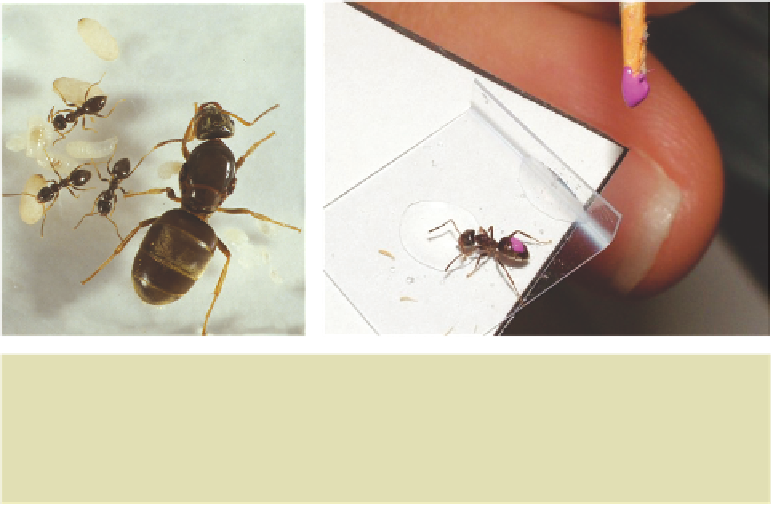Biology Reference
In-Depth Information
(a)
(b)
Fig. 13.3
(a) An incipient colony of
Lasius niger
with the larvae, pupae and first
workers that a founding queen produces after about three months, solely from her
own body reserves and a bit of drinking water. Photo © David Nash. (b) As with many
insects, dots of paint can be used to distinguish individual ants in colonies being
observed. Photo © Francis Ratnieks.
their ovaries do not mature and they never take part in a nuptial flight. In successive
years the colony and its nest continue to grow, until after some years it contains several
thousands of workers and still a single queen who lays the eggs. At this stage the colony
starts to produce a new cohort of reproductives, winged females and males that eventually
leave the colony on their nuptial flights. The old colony may continue reproducing in this
way for another decade, but as soon as the old queen dies and stops laying eggs to
replenish the worker force, the colony dwindles in size and dies off.
This picture of the life cycle is typical of many temperate zone ants, although of
course the details vary greatly from species to species. The details of worker behaviour
are also very variable, but the following generalizations are typical of many species.
Workers usually spend the first few weeks of their lives inside the colony handling dead
prey which have been brought back by foragers, feeding the larvae and the queen with
regurgitated food, cleaning the nest and guarding the entrance. Later in life (this change
takes place at an age of about 40 days in
Formica polyctena
, a species which has been
studied in detail) workers begin to do jobs outside the colony, mainly foraging and
defence against enemies. The total length of life of ant workers is not very well known
but probably ranges from a few weeks to a few years. In wasps and bees, workers usually
live for about 3-10 weeks. In addition to changes in worker behaviour with age, in some
species of ants there are two castes of worker (both sterile females): soldiers and normal
workers. Soldiers are usually larger and have large heads with jaws or glands for
producing defensive secretions. As their name implies they are specialists in colony
defence.
The females belonging to different castes (queen, worker, soldier) do not usually differ
genetically; the determination of caste depends on environmental conditions during
Typical worker life
cycles






























